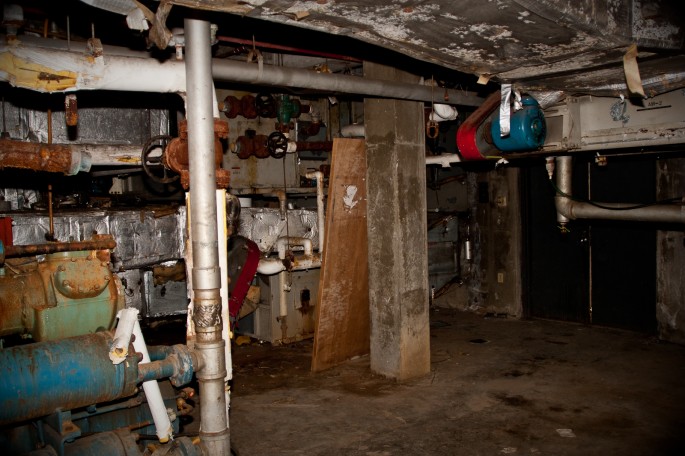2. ST. ALBANS SANATORIUM – RADFORD, VIRGINIA
St Albans Sanatorium. Hostages, soldiers, bullied boys, and the mentally ill – Radford sanatorium offers ghosts aplenty.

Image Source: Maryland Ghost Trackers
Where pain and torment are experienced on a daily basis, ghosts are sure to dwell. And few places are as acutely stained with agony as old mental hospitals. That’s because both their facilities and staff left much to be desired.
In the 1900s, the mentally ill were basically lab rats for doctors, who were more than eager to test out experimental procedures on them. As a result, the dead usually outnumbered the living in early sanatoriums. Those who weren’t killed during some pilot medical trial usually just chose to off themselves, so depressing were hospital environments. Thus, many of these old mental institutions are rumored to be haunted. But only one has beaten out other types of paranormally busy sites (such as cemeteries and battlefields) to become known as the “most active location on the east coast”1: St. Albans Sanatorium. The hospital’s haunted story begins before it was even built.
St. Albans Sanatorium is located in Radford, Virginia. During the 1700s, the city’s close proximity to the New River Watershed attracted Native Americans and early European settlers alike. Competition over the area resulted in hostilities between the two groups. In July 1755, a group of Shawnee Indians brought tensions to a climax. They attacked and looted the colonists of Draper’s Meadow, killing at least five people and taking others as hostage. To survivors, the Shawnee left behind grisly reminders of their wrath. The Lybrook couple2, for instance, was presented with a bag containing the decapitated head of Philip Barger.
Mary Draper Ingles was one of those held for ransom at the Shawnee town ofSonnontio3. Before she was taken prisoner, Mary first had to witness the gruesome deaths of her fellow colonists, including her mother and sister-in-law’s baby. Though there are variations in what she saw, all accounts are extremely bloody:
“Eleanor Draper was tomahawked and scalped. Betty Draper’s infant child was brained against the side of one of the cabins […]”4
Mary eventually managed to flee from Sonnontio, but her journey back home was not an easy one. Some sources say that she was forced to abandon the baby she’d given birth to during her captivity. Others claim that her fellow escapee, a German woman, attempted to eat her twice, so hungry were the pair during their forty-three day, one-thousand mile trek.

Image Source: Graphic Enterprises
The horrors Mary Draper Ingles faced during the Drapers Meadow Massacre are the first to contribute to St. Albans Sanatorium’s scary past. Next up are what soldiers endured during one of the Civil War’s most violent battles, the Battle of Cloyd’s Mountain. According to St. Albans, “Union artillery bombarded the settlement of Central Depot from the ridge where St. Albans stands today.”5 This explains why many people who have visited the building report of hearing rifle shots, smelling gun smoke, and seeing spectral mists rise from the hospital’s surrounding grounds.
St. Albans Sanatorium was constructed in 1892, though it first functioned as a Lutheran Boys School. Unfortunately for George W. Miles, the man behind the school’s inception, students were a far cry from the “future southern gentlemen”6 he had envisioned. As Headmaster, Miles demanded boys to perform well in classrooms and on sports fields. To meet such high expectations, many would turn to extreme methods. St. Albans thus “quickly developed a reputation for being a rough and competitive school where bullying was not only condoned, it was encouraged.”7 Heated athletic rivalries may have allowed St. Albans to secure numerous football championships, but they also made homicides and suicides frequent occurrences on campus.

Image Source: Cardcow.com
After Miles’ death in 1903, enrollment at St. Albans quickly fell, and so it closed eight years later. In 1916, Dr. John C. King acquired the property to now fulfill his vision: introducing the nation’s first top-notch psychiatric hospital. Unhappy with the conditions at the Southwestern Lunatic Asylum during his stint as superintendent, Dr. King wanted to open an institution where patients would be both well treated and well accommodated. Thus, he made several renovations to the school’s remnants, even adding a farm to the property in order to give patients a proper place to exercise and play.
Unfortunately, just as Miles’ school didn’t produce the “gentlemen” he’d wanted, neither would King’s St. Albans Sanatorium deliver his goal of high recoveries.
The history of psychiatric treatment methods during the 1900s is a story of failures replacing failures. Insulin-induced comas and lobotomies would leave patients either brain dead or really dead, for example. These procedures were also very labor intensive, and St. Alban’s staff-to-patient ratio in 1945 was a sad 48 to 6509.
When cutting people’s skulls open proved ineffective, doctors opted to simply shock them to their senses. Schizophrenics, for instance, were given electroconvulsive therapy, which was deemed safer than insulin coma therapy. Still, ECT had many possible dangerous aftereffects, including “fractures, severe memory loss, and spontaneous seizures.”8
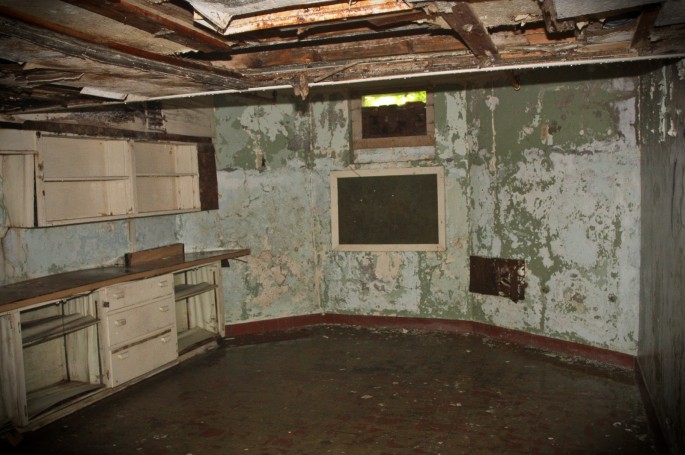
Image Source: St. Albans
Some of St. Albans Sanatorium’s most active rooms are where hydrotherapies were conducted. A hydrotherapy session didn’t always involve a brief, relaxing soak in the bathtub. Patients who weren’t mummified in icy cold towels were strapped into steaming water vats, where they lay immobile and confined for days. Others were “blasted with water from a fire hose.”9 No wonder one of these rooms is now known as the Suicide Bathroom10.
There are many other rooms in the sanatorium that are paranormally hot. The Bowling Alley in the basement, for instance, is known to be haunted by two female spirits: “Allie” and Gina Renee Hall. Allie is rumored to be the young daughter of one of the hospital’s patients, and Gina was a woman who was murdered on June 28, 1980 somewhere close to St. Albans Sanatorium, along Hazel Hollow Road.
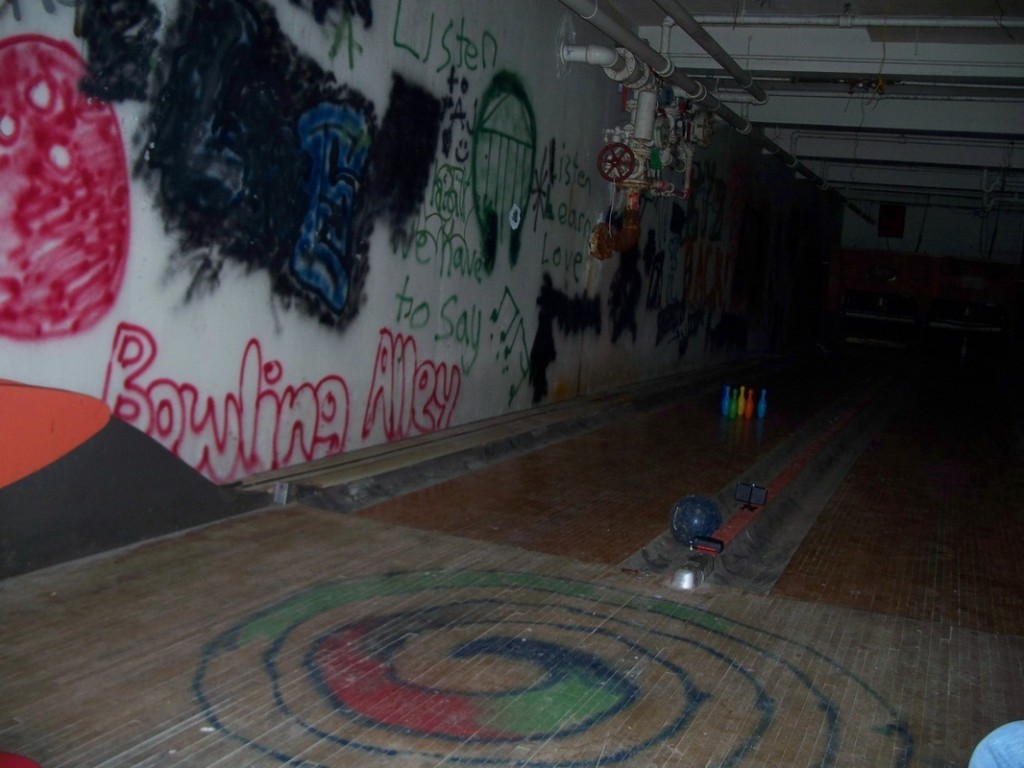
Image Source: Maryland Ghost Trackers
In the 1990s, the Carilion Health System acquired St. Albans Sanatorium, but vacated the property in 2003 (perhaps ghosts drove them out?) After a brief stint as an abandoned “site of theft, vandalism, and late-night parties,”11 St. Albans got the attention of Tim Gregory, a previous patient at the hospital. As the property’s new owner, he made it his mission to renovate its remaining buildings and transform it into “a Research and Enlightenment Center.”12 Today, to fund these efforts, he hosts “a number of macabre events”13 at St. Albans Sanatorium, including an annual Haunted House Halloween extravaganza. As guests roam through the building, they encounter zombies and mental patients, but can’t always be sure if they are staged or real.
Both private and public ghost hunts are also held at St. Albans Sanatorium. They are conducted and led by teams of paranormal experts, such as 3:33 AM Paranormal andSeven Hills Paranormal14. During a visit in 2011, 3:33 AM Paranormal recorded a ghost whispering what sounds like “Deborah”15 in the infamous Electroshock Therapy Room.
Black Raven Paranormal16, in search of a new fascinating case, stopped by St. Albans Sanatorium in 2013. In the small bathroom located in the women’s ward (the aforementioned Suicide Room), one team member was definitely touched by something. Perhaps it was the ghost of one of the four people rumored to have killed themselves in the spooky laboratory.
One year later, Maryland Ghost Trackers would also experience a similar “spirit jumping”17 at St. Albans Sanatorium. During that memorable investigation, they also recorded several audio anomalies and captured a strange shadow18 fleeing down the stairs.

Image Source: Maryland Ghost Trackers
Today, the conditions inside St. Albans Sanatorium are a mix of good and bad, of real and staged damage. On walls that have not been destroyed or fallen apart, graffiti stains their plaster. Broken wheelchairs and rusted gurneys lie scattered in old operation rooms, and patient wards seem more “cellblock” than dormitory. Staff quarters are just as gloomy and in a state of disarray.
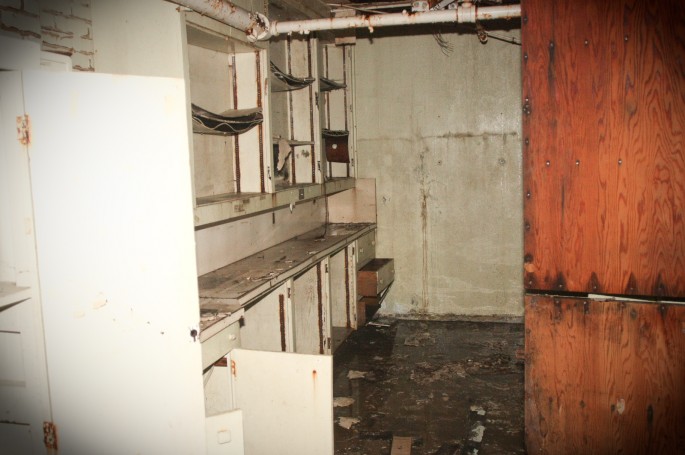
Image Source: St. Albans
Besides seeing how horrible things were at St. Albans Sanatorium during the 1900s, visitors can also sense it. The hospital reeks of torment, because this was what was experienced by both patients and staff. The admitted were prodded and probed, abused or neglected by practitioners. The employed were overworked, inexperienced, and probably became very depressed themselves. Even in death, they cannot rest peacefully.
St. Albans Sanatorium thus quickly earned a reputation for being a hotbed for paranormal activity. Much evidence supports this notoriety. Full body apparitions have been photographed in the old alcoholics’ ward, for instance. Tourists and experienced ghost hunters alike have heard disembodied conversations, screams, and footsteps. Some have seen objects move on their own, or been pushed by invisible forces themselves. The hospital’s maze-like configuration also makes it easy for visitors to get lost, making explorations both scary and dangerous. For several paranormal film makers, then, St. Albans Sanatorium was the perfect place to shoot some scary footage.
In 2011, The R.I.P. Files19 featured the institution in one of their web series episodes. After that, SyFy’s Haunted Collector team took a trip to the hospital, in hopes of giving it a much-needed spiritual detox. St. Albans Sanatorium also starred in the Travel Channel’s The Dead Files, a show about a psychic medium who teams up with a homicide detective to investigate places rumored to be haunted. Finally, in the Ghost Asylum episode which aired on May 3, 201520, the Tennessee Wraith Chasers conducts a successful investigation at the property.
So if you are passing through Radford, Virginia, make sure to take a tour of St. Albans Sanatorium. Want to see a chair rock on its own? Stop by the hospital’s Rocker Room21. Looking to exchange some friendly whistles with a ghost? Check out the Whistle Room22. Hoping to encounter a more hostile entity? The Boiler Room23 won’t leave you disappointed!
The Boiler Room.
Image Source: St. Albans
Book a Williamsburg Tour and see for yourself
Our tour will take you on a leisurely stroll along the tree-lined cobbled streets of this beautiful and historic city. In around three-quarters of a mile on our standard tour, our entertaining and knowledgeable guide will regale you with stories of characterful spots in the Historic District of Williamsburg.
For those with an appetite for the terrifying, our extended tour will take in an additional haunted locations.
Get more information and reserve a tour today!
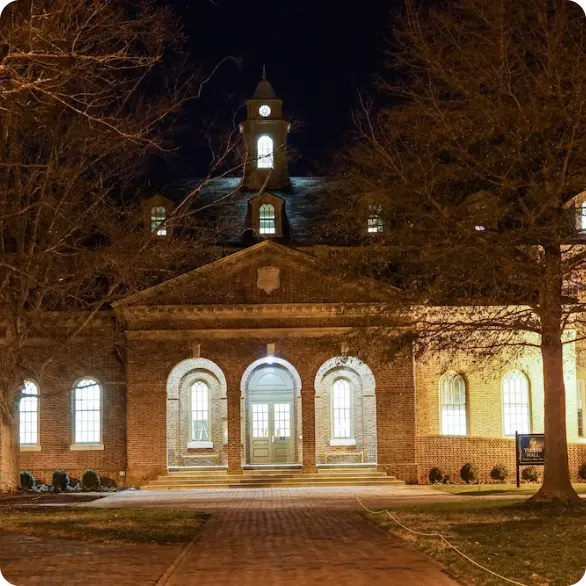
Works Cited
- “History.” About Us. St. Albans Sanatorium. St. Alban’s, 2015. Web. 12 September 2015. Para. 1.
- “Mary Ingles’ Escape Story Like ‘Thriller’ Fiction Tale.” Charleston Daily Mail. 4 June 1837. Web. 12 September 2015.
- Duvall, James. Mary Ingles and the Escape from Big Bone Lick. Burlington: Boone County Library, 2009.
- Streiff. “July 30, 1755. Massacre at Drapers Meadow.” RedState.com. 30 July 2015. Web. 12 September 2015. Para. 3.
- “History.” About Us. St. Albans Sanatorium. St. Alban’s, 2015. Web. 12 September 2015. Para. 2.
- “When the Boys Came to Town.” The Commercial Investment Multiple Listings Service, n.d. e1 Solutions, Inc., 1999-2014. Web. 12 September 2015. Page 1.
- Newkirk, Dana. “Visit St. Albans Sanitarium, one of America’s most haunted asylums.”Roadtrippers. 3 September 2014. Web. 12 September 2015. Para. 1.
- “Primary Sources: Insulin Coma Therapy.” American Experience – A Brilliant Madness.PBS.org, n.d. Web. 12 September 2015. Para. 4.
- Greenberg, Dan. “10 Mind-Boggling Psychiatric Treatments.” Mental Floss. 7 September 2012. Web. 12 September 2015. Para. 5.
- “Suicide Bathroom.” Explore. St. Albans Sanatorium. St. Alban’s, 2015. Web. 12 September 2015.
- Matzke-Fawcett, Amy. “St. Albans property may be put to rest.” The Roanoke Times. 12 August 2011. Web. 12 September 2015. Para. 9.
- “St. Albans to host ‘Ghost Hunters’.” The Southwest Times.24, September 2010. Web. 12 September 2015. Para. 4.
- Atkins, Aaron. “St. Albans plays on dark side of Valentine’s Day.” Radford News Journal. 22 February 2013. Web. 12 September 2015. Para. 21.
- “St. Albans Psychiatric Hospital.” Seven Hills Paranormal. Posted by admin on 17 August 2012. Web. 12 September 2015.
- Marin, Patricia. “3:33 AM Paranormal captures disembodied voice at St. Albans.”Examiner.com. 13 October 2011. Web. 12 September 2015. Para. 1.
- “St. Albans Sanatorium – Radford, Virginia.” Black Raven Paranormal. Investigation Dates: May 4 – May 10, 2013. Black Raven Paranormal & Marty Seibel, 2014. Web. 12 September 2015.
- “St. Albans Sanatorium.” Maryland Ghost Trackers. 28 June 2014. Web. 12 September 2015. Para. 15.
- “St Albans Santorium.” Uploaded by kreagerm. Youtube. Video. 31 July 2014. Web. 12 September 2015.
- “Ep 5: St Albans Sanatorium: The R.I.P. Files Web Series.” Mingle Media TV Network. 7 February 2011. Web. 12 September 2015.
- Dillard, Mechele R. “GHOST ASYLUM: TWC Work to Unlock Murder Mystery at St. Albans! (Video Exclusive.)” TVRuckus. 3 May 2015. Web. 12 September 2015.
- “Rocker Room.” Explore. St. Albans Sanatorium. St. Alban’s, 2015. Web. 12 September 2015.
- “Whistle Room.” Explore. St. Albans Sanatorium. St. Alban’s, 2015. Web. 12 September 2015.
- “Boiler Room.” Explore. St. Albans Sanatorium. St. Alban’s, 2015. Web. 12 September 2015.

